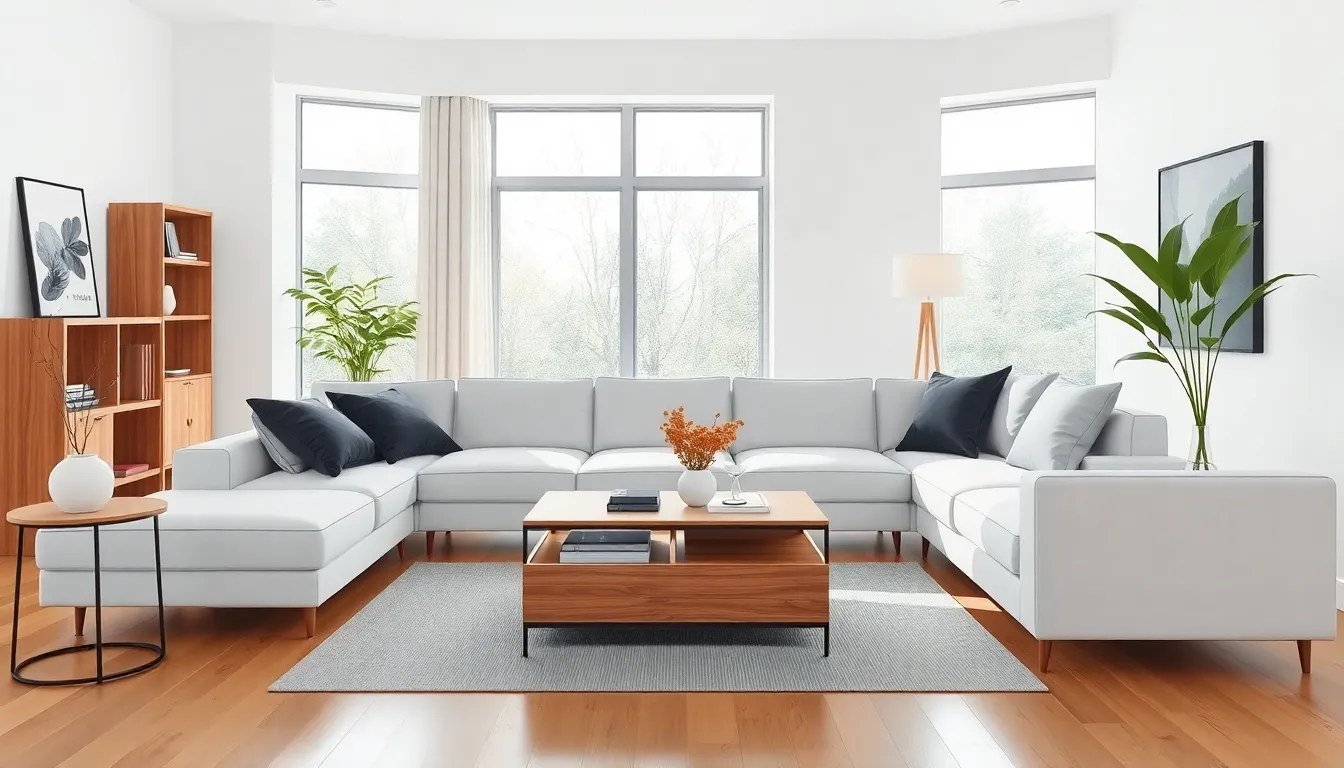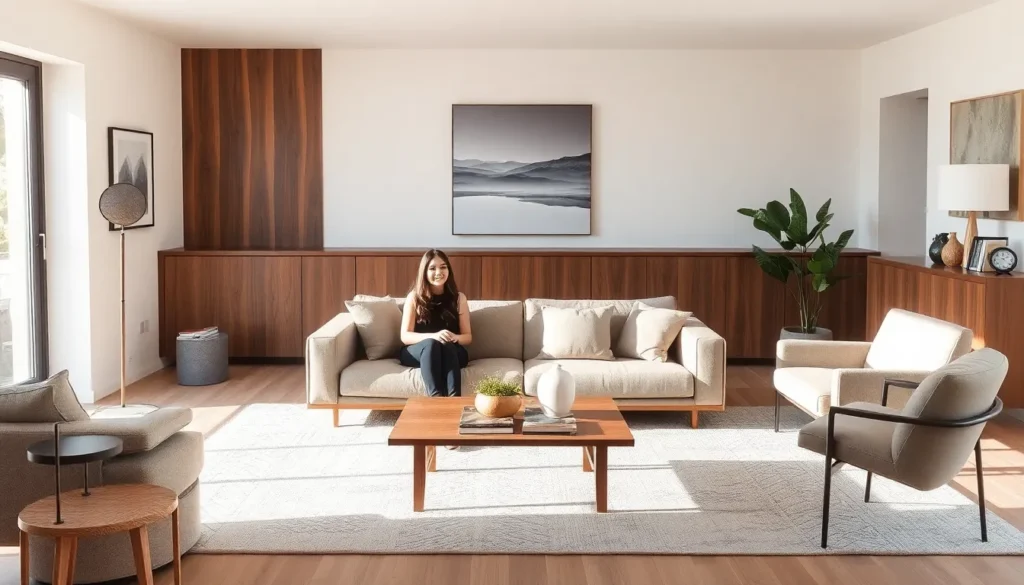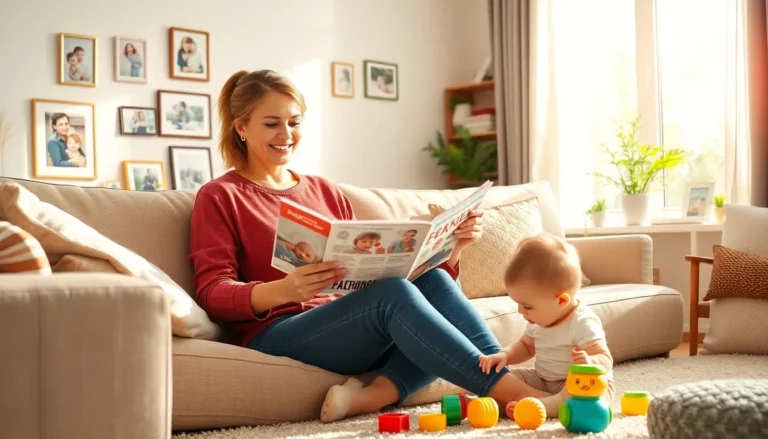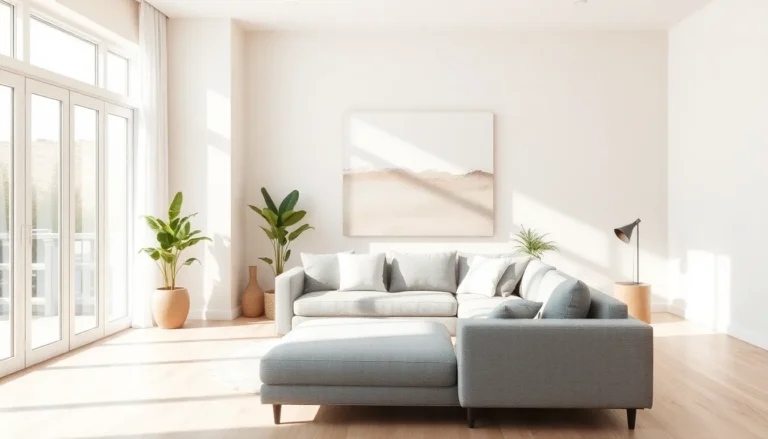Table of Contents
ToggleImagine walking into a living room that feels like a breath of fresh air, where every piece of furniture whispers elegance and simplicity. Minimalist furniture isn’t just a trend; it’s a lifestyle choice that transforms cluttered chaos into serene sophistication. With sleek lines and functional designs, it’s like giving your space a much-needed spa day—no cucumber slices required.
In a world where distractions lurk behind every corner, embracing minimalism in your living room can be a game changer. It’s not about living like a hermit; it’s about curating a space that speaks to your soul while keeping the chaos at bay. So, if you’re ready to swap out that overstuffed couch for something chic and functional, buckle up! This journey into the world of minimalist furniture will leave you wondering how you ever lived without it.
Understanding Minimalist Furniture
Minimalist furniture embodies simplicity and functionality. It reflects a lifestyle focused on reducing excess and enhancing comfort in living spaces.
Definition of Minimalism
Minimalism prioritizes essential elements, favoring quality over quantity. This approach eliminates unnecessary decor, creating environments that evoke calmness. In minimalist design, each piece of furniture serves a purpose, contributing to an uncluttered aesthetic. Essentially, minimalism champions the idea that less truly means more, encouraging individuals to embrace open spaces. By removing distractions, minimalist approaches cultivate mindfulness in everyday life.
Principles of Minimalist Design
Minimalist design revolves around several key principles. Functionality stands as a top priority, ensuring every item fulfills a specific purpose. Clean lines and geometric forms dominate shapes, minimizing visual clutter. A neutral color palette enhances the serene atmosphere, favoring whites, grays, and earth tones. Natural materials, such as wood and metal, create a sense of warmth while maintaining simplicity. Ultimately, these principles work together to foster an environment that promotes relaxation and harmony in living areas.
Benefits of a Minimalist Furniture Living Room

Minimalist furniture offers numerous advantages for living spaces. This design approach fosters a tranquil atmosphere while promoting simplicity and functionality.
Space Optimization
Effective space utilization defines minimalist furniture. It encourages the selection of essential pieces, which maximizes available square footage in small areas. By choosing sleek designs, individuals avoid overcrowded rooms, allowing for easy movement and flow. Multi-functional furniture, such as a coffee table with storage, elevates practicality while preserving openness. Organizing spaces around fewer items creates a sense of calm, which is particularly valuable in urban living scenarios.
Improved Aesthetics
Minimalist design enhances visual appeal significantly. Minimalist furniture emphasizes clean lines and neutral palettes, contributing to an elegant, cohesive look. Soft textures and natural materials add warmth, transforming rooms into inviting spaces. By focusing on a few carefully selected decor elements, individuals draw attention to quality over quantity. Balanced arrangements create harmony, reducing visual clutter and promoting relaxation. This aesthetic simplicity invites a sense of sophistication, making everyday living more enjoyable.
Choosing Minimalist Furniture
Selecting the right minimalist furniture requires attention to specific features that promote simplicity and functionality. Identify key characteristics to create an inviting living space.
Key Characteristics to Look For
Focus on clean lines and geometric forms, which define minimalist furniture. Look for items that serve dual purposes, enhancing functionality without cluttering the area. Prioritize quality over quantity, ensuring each piece contributes meaningfully to the design. Consider scalability to accommodate various spaces, especially in compact living rooms. Also, opt for furniture that maintains a harmonious balance within the arrangement, creating a visually pleasing atmosphere.
Material and Color Considerations
Choose natural materials like wood, metal, and stone to reflect minimalism’s essence. Select a neutral color palette, including whites, beiges, and soft grays, for a calming visual effect. Incorporate textures that add warmth without overwhelming the senses, balancing aesthetic appeal with practicality. Consider sustainable options that align with minimalist values, promoting eco-friendliness alongside style. Use color accents sparingly to inject personality while maintaining serenity in the overall design.
Designing Your Minimalist Living Room
Designing a minimalist living room involves careful attention to layout and furniture selection. Space should promote openness while reflecting a serene atmosphere.
Layout Tips
Prioritize function by arranging furniture to encourage conversation. Consider a focal point like a coffee table or a statement chair. Maintaining ample space between pieces allows for easy movement. Utilize area rugs to define spaces and create warmth. Identify zones for different activities, such as reading or relaxing, to foster a cohesive design. Also, use vertical space for storage to keep the floor area uncluttered. Natural light should flow unobstructed, enhancing the calm ambiance throughout the room.
Essential Furniture Pieces
Select furniture that embodies simplicity and elegance. A low-profile sofa can serve as a comfortable but unobtrusive seating option. Consider a minimalist coffee table that offers practical storage solutions. Use armchairs designed for both comfort and style without overwhelming the space. Showcase a single statement piece of art for visual interest without distraction. Multi-functional items, such as ottomans that serve as storage, enhance utility while maintaining a clean aesthetic. Prioritize quality materials like wood and metal to ensure durability and value in your choices.
Maintaining a Minimalist Living Room
Maintaining a minimalist living room requires intentional decisions and regular upkeep. Keeping the space serene and clutter-free enhances overall functionality and comfort.
Decluttering Strategies
Establishing a decluttering routine supports a minimalist lifestyle. Start by evaluating each item for its necessity and purpose. Focus on keeping only essential furniture pieces that contribute to the space’s harmony. Implement seasonal assessments to remove items that no longer serve a function. Utilize storage solutions like baskets or hidden compartments to organize smaller items discreetly. Encourage a ‘one in, one out’ rule to maintain balance when acquiring new decor. Emphasizing simplicity facilitates a more tranquil environment.
Routine Maintenance Tips
Regular cleaning sustains the aesthetic appeal of a minimalist living room. Dust surfaces weekly using a microfiber cloth, focusing on furniture with clean lines. Consider vacuuming or sweeping floors multiple times a week to remove debris and maintain clarity. Schedule deeper cleans monthly, including under furniture and in storage areas. Ensure materials like wood and metal receive appropriate care to prolong their lifespan. Lightly rearranging decor occasionally brings freshness without overwhelming the minimalist design. Prioritizing upkeep fosters a serene atmosphere and enhances daily living experiences.
Embracing minimalist furniture in the living room creates a harmonious and inviting environment. By focusing on simplicity and functionality, individuals can transform their spaces into serene retreats that promote relaxation. The thoughtful selection of essential pieces enhances both aesthetics and practicality while reducing visual clutter.
Maintaining a minimalist living room requires intentional choices and regular upkeep. By evaluating belongings and implementing smart storage solutions, anyone can sustain a tranquil atmosphere. Ultimately, the journey towards minimalism not only elevates living spaces but also enriches everyday experiences, making each moment feel more meaningful.







